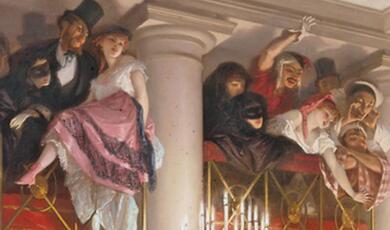01 April 2014
The Girl of the Period
Professor Lynda Nead
SLIDE: W.P.FRITH, The Times of Day. 2. Noon – Regent Street, 1862.
In this series of lectures I have been discussing the role of fashionable dress and appearance in defining men’s and women’s social and moral identity in the middle decades of the nineteenth century. This was a dynamic period when the system of seasonally changing fashion, with which we are now so familiar, became established and when the streets of modern cities such as Paris and London became stages for the performance of fashionable display. With the introduction of new forms of window display and wider pavements, major cities in this period were beginning to be the visual feasts that they are today, and men and women visited the city to look and to be looked at.
It was in this environment of visual ostentation and promiscuity that more traditional and conservative commentators claimed that there were clear visible distinctions between the respectable and the non-respectable; that even though the crowds on the city streets seemed more congested and heterogeneous, details of dress and appearance could be observed and read and an individual’s moral and social identity clearly determined by these outward signs.
SLIDE: ‘As I Was / As I Am’, Contrasts, c.1850.
In the previous lecture I looked at the ‘woman in red’, the dress and appearance of the fallen woman and how through the repetition of particular physical elements such as the showy or gaudy dress, short skirt length, kid boots and feathered bonnet, across a range of discourses including novels, medical texts and paintings, a stereotype was established of the sexually deviant woman that suggested that once a woman had ‘fallen from virtue’ she became visibly separate from respectable society and was trapped in an inescapable downward progress until she met a tragic and premature death. Ideologically the importance of this myth of the dress and appearance of the prostitute was the way in which it functioned to differentiate the pure and the fallen and through its claim that these differences were visible and permanent; an outward expression of moral character.
SLIDE: C.J.CULLIFORD, Scene in Regent Street. Philanthropic Divine: ‘May I beg you to accept this good little book. Take it home and read it attentively. I am sure it will benefit you.’ Lady: ‘Bless me, Sir, you’re mistaken. I am not a social evil, I am only waiting for a bus.’ c.1865.
And yet, this system of visible distinction, seemed to be constantly breaking down when faced with the social actualities of the streets of the mid-nineteenth century city. Rather than prostitutes and fallen women being clearly distinguishable there were endless cases of mistaken identity.
See the print by C.J. Culliford; and the instances of wrongful arrest by police who were unable to tell whether women were prostitutes and soliciting clients or were simply modern women adopting new kinds of style and behaviour.
The system was under attack because modern women were present on the streets of the city in ways that transgressed traditional standards and expectations. They did not act in or look the same way that girls had in the past. Fashionable femininity threw a spanner in the works of conservative discourses of gender and morality; these were women who followed the latest fashions and flaunted their looks and clothes. Modern, young and advanced, these were women who had been created in equal part by the fashion system and the streets of the great capitals.
In the second half of the nineteenth century Paris had produced a new kind of citizen/consumer, the Parisienne – a chic modern consumer of the latest fashions, a woman who had honed her expertise in accessorizing and who had turned women’s dress into a religion. Although in one respect the fashionability of the Parisienne supported French commerce and manufacturing and was a symbol of the French consumer economy that was circulated both nationally and internationally, on the other hand its superficiality and idolization of appearance eroded the more traditional values that celebrated moral and spiritual excellence over cut of cloth and choice of hat and gloves. It was a world in which appearances were no longer necessarily indices of respectability and in which mistakes could and would be made.
SLIDE: ‘A woman of the world and a cocotte. – Bah! Which one is the cocotte?’, Le monde comique, 1875-6.
Parodies the ‘before and after’ style of image; here the woman of the world and the cocotte are simply mirror images of each other.
SLIDE: ‘A man who follows women’, La vie amusante, 1878-9.
A man takes a fancy to a woman in a street; he has ten francs to pay for her but begins to be uncertain about whether she is sexually available or respectable. Second image: ‘The dickens! She has the air of being an honest woman. That’s charming but annoying.’ He trails after her trying to pluck up courage to speak to her and in the end gets a door in his face: ‘I really don’t have any luck! I always happen upon honest women.’
SLIDE: Jules CHÉRET, A la Parisienne, 1887.
The Parisienne appeared in both the mass media and in avant-garde painting; on posters advertising Parisian department stores, journals and catalogues. As art historian Ruth Iskin observes in her book Modern Women and Parisian Consumer Culture in Impressionist Painting, one department store actually called itself ‘La Parisienne’ and Jules Chéret’s poster for the store shows the way in which the figure of the fashionable Parisienne, ‘with her regalia of up-to-date fashion and accessories’ was used to attract female customers. As Iskin comments: ‘The message was that by buying the constituent items, composing them and thus emulating the image, any department store customer could become a chic Parisienne.’ So the Parisienne was a figure of highly conflicting associations: on the one hand, she was an icon of the modern French consumer economy and of the link between France and haute couture that was being marketed as a global brand; on the other hand, she was so wrapped up in her endless search for the latest ensemble and matching accessories that she had lost her moral compass and was no better than and could not be distinguished from a high class prostitute. We will see similar sets of ideas emerging in the context of British discourses on fashionable femininity.
SLIDE: A.RENOIR, The Parisienne, 1874.
In 1874-5 both Manet and Renoir painted full-length versions of the modern Parisienne. Both images are like painted fashion plates; with no figurative background, all the visual attention is drawn to the women in their fancy day dresses, with their moulded silhouettes, cinched waists and high-buttoned collars.
SLIDE: E. MANET, La Parisienne, c.1875
As the wonderful catalogue to the 2013 exhibition of Impressionism, Fashion, and Modernity points out, interest in women’s dress was at its height in the second half of the 1870s, with writers such as Baudelaire and Mallarmé describing fashion as a symbol of the fleeting modernity that characterized the contemporary city. The chic women portrayed by Manet and Renoir might be members of the grande bourgeoisie or women of the world; they might be wives or courtesans, but regardless of their social status, they all prized elegance and the art of dressing above all else.
In the 1880s James Tissot executed a series of fifteen paintings on the theme of ‘Femmes à Paris’, which can be seen as the apotheosis of fashionable French femininity in this period. Tissot had left Paris and moved to London in 1871 during the Franco-Prussian War, where he established his reputation as a painter of scenes of fashionable life and high society and stayed until 1885 when he returned to Paris and planned his major one-man show.
SLIDE: J. TISSOT, L’Ambititeuse (The Political Lady), 1883-5.
Tissot’s ‘Femmes à Paris’ series is a taxonomy of contemporary, fashionable femininity; a selection of female types in a range of modern settings that define what it is to be a late-nineteenth century woman in Paris. The women in these images are always impeccably dressed and aware of themselves as objects to be looked at. In L’Ambitieuse (The Political Lady) Tissot skilfully depicts the different textiles, accessories and luxurious surfaces worn by the woman: the tiers of stiff, pleated flounces contrasting with the soft feather fan. She enters the room on the arm of an elderly man and turns towards the viewer of the painting, acknowledging the attention that she has aroused among the figures around her.
SLIDE: J. TISSOT, La Mondaine (The Woman of Fashion), 1883-5.
The way in which fashion is used by the ‘femme à Paris’ is the subject of other paintings in Tissot’s series, such as La Mondaine (The Woman of Fashion). Here, again, an extremely fashionable young woman is accompanied by a much older gentleman; lace, fur, velvet and exquisite detail are part of the woman of fashion’s armory, which she deploys to get ahead in the world and it is no surprise that she shares a satisfied smile with the viewer.
SLIDE: J. TISSOT, Les Femmes de Sport (The Sporting Ladies), 1883-5.
Tissot evokes a world of social display in which men and women dress to attract interest and are aware of being looked at. Although The Sporting Ladies are located in a fashionable circus, the audience seem more interested in looking at each other than at the acrobatic performers. The men and women are animated and alert, looking through opera glasses, turning to talk to each other, smiling and gossiping.
SLIDE: J. TISSOT, Les Femmes de Sport (detail).
Tissot plays with the idea of performance here, as the audience seems to be performing as much as the acrobats and the picture reveals the layers of display and fashionable consumption involved in being a modern Parisienne.
SLIDE: J. TISSOT, La Demoiselle de Magazin (The Shop Girl), 1883-5.
In La Demoiselle de Magazin (The Shop Girl) the woman’s gaze is even more explicitly directed towards the viewer of the image, as a young assistant opens the door and holds a parcel for a departing customer. Again the image is teeming with textures, look at the untidy jumble of fabrics and ribbons on the counter, which seem to invite a tactile response from the viewer. But is this all that is on sale in this image? There is another exchange of glances in this picture.
SLIDE: J. TISSOT, La Demoiselle de Magazin (detail).
As the shop girl locks eyes with the viewer, another assistant reaches up to put a box on a high shelf and looks out of the window from where she must surely meet the gaze of the bearded gentleman in the street. Shopping, in this period, was often associated with sex; even the phrase used for window shopping – lèche vitrine literally translated as to lick the window – evoked the erotic connotations of modern consumption. Tissot deliberately places the man’s head over the torso of the display dummy in the window and the conflation of shop interior and street and of selling clothes and selling bodies is both unmistakeable and unavoidable.
Tissot’s series ‘Les Femmes à Paris’ evokes a highly charged urban world in which fashion is part of a self-conscious erotic display and where female sexual morality is uncertain or ambiguous and appears to be as much for sale as the goods in shop windows. In London, fashionable dress seemed also to have created an environment in which women were bold and assertive and where the differences between the respectable and the non-respectable had disintegrated.
Two episodes in particular – one in 1862 and one in 1868 – seemed to typify contemporary confusion about modern femininity and generated massive amounts of public debate in the periodical press and newspapers.
SLIDE: W. P. FRITH, The Times of Day. 2. Noon – Regent Street, 1862.
On 7th January 1862 The Times published an angry letter from ‘Paterfamilias from the Provinces’. The correspondent explained that his daughter had been the subject of a cowardly assault while walking in the streets of London. As a stranger to the metropolis, he had been surprised by advice from acquaintances that his daughter should be accompanied by a servant or older relative when out in public. He ignored this advice and was now appalled to inform readers of the paper that his daughter and a female relative had been followed when visiting Oxford Street. It was an outrage, he concluded, that innocent girls could not walk in London unaccompanied without being bothered by the stares and comments of scoundrels masquerading as gentlemen.
The publication of this letter stimulated an intense debate in the press about men, women, respectability and streets in mid-Victorian London. The first to reply to Paterfamilias was ‘Puella’, who declared that she had walked alone in Oxford Street on many occasions and had never received any incivility. Perhaps, she suggested, the provincial girls had invited attention; if country girls want to go shopping, the letter continued, ‘dressed in red cloaks and pork-pie hats with white feathers…they cannot escape the notice of those despicable idlers…who take advantage of the weakness of women.’ Really respectable women, ‘Puella’ continued, who do not wish to attract attention, should assume a quiet dress and manner when unaccompanied in the city.
The debate that began to take shape in the letter columns of The Times reveals how public behaviour and appearance were beginning to shift in the 1860s and how this, in turn, was creating different kinds of encounters on the streets of the city. The original incident wasn’t just a question of the blurring of identities between the respectable woman and the prostitute; the idler does not mistake the country girls for prostitutes, but for naïve young women who may be open to sexual flirtation. This kind of encounter – sought for, or uninvited – was a possibility on the streets of the metropolis.
Paterfamilias sprung to the defence of his daughter and her companion and the doubt cast by ‘Puella’ on their behaviour. They had not incited any advances through their dress, for they had been in ‘plain mourning’ to respect the recent death of Prince Albert. A few days later, however, another correspondent, calling themselves ‘Common Sense’ offered another interpretation of the incident: girls nowadays go out and are deliberately flirtatious and Paterfamilias had better come to terms with it. The letter imagines the behaviour of Paterfamilias’s girls that day. Fathers cannot believe, it suggests:
SLIDE: ‘Common Sense’, letter to The Times, 21 January 1862, p. 10.
That Blanche ever looked kindly at a strange joli garçon who appeared struck with
her appearance; or that Isabel ever designedly showed rather more than her very
neat ankle to a young officer crossing the street. It never occurs to them that bonnets
of the ‘kiss me quick’ build, loud stockings, exaggerated tournures, capes and
crinolines; vagrant ringlets straying over the shoulder, better known as ‘follow
me, lads’, and suchlike decoys, are all unmistakeably intended to attract the notice
and attention of the male sex…Blanche and Isabel take a good deal of notice
of the young men in a quiet way when they walk out alone, and are not at all
displeased of being taken notice of themselves…Many little harmless and interesting
adventures may occur to the dear girls during their morning walks of which they
say nothing at all when they return home.
SLIDE: W. P. FRITH, The Times of Day. 2. Noon – Regent Street, 1862.
The problem is, then, that respectable girls are not staying put; they walk unaccompanied in the west end of London and this can provide sought-after opportunities for sexualised encounters with strangers. On the streets, details of dress, gesture and glance are ambiguous and can convey social status or flirtatious availability. In the light of this cacophony of voices we can look again at the two women in the centre of Frith’s panorama of ‘Noon in Regent Street’ and be confident that whatever uncertainties we may have about their identity were shared by people on the streets and in the art galleries in the mid-nineteenth century.
The fall-out from the incident spread to the illustrated periodical press and offered Punch the opportunity for some misogynistic digs at one of their favourite comic types: the unattractive spinster.
SLIDE: ‘Prudence. Matilda: “Well, dear, no one ever presumed to address me; still, after all the letters in the papers no girl of prepossessing appearance should ever go out unprotected…”’, Punch, 1 February 1862, p. 44.
SLIDE: ‘Mistaken Identity. Terrified Spinster: “Oh, Mr. Policeman, I do believe here is one of those Ruffianly Libertines about to speak to me.”’, Punch, 8 February 1862, p. 58.
Easier to poke fun at ugly old women than to come to terms with the confusion on the streets of modern cities.
There is one last element in this discourse on streets, sexuality and sight that introduces a woman who was also to play a central part in the later debate of 1868. In April 1862 Temple Bar published an article called ‘Out Walking’ by the novelist and journalist, Eliza Lynn Linton. The piece suggests that if a woman behaves and dresses properly, if she does not linger in front of shop windows, walks with purpose, does not attract attention and ignores passing men, then she is perfectly safe and at home in the city. Any sign that women are enjoying the city, that they are participating in its visual culture and ocular freedom, can be taken as a sign of their lack of modesty. London in the 1860s was a dynamic and changing society; the only way for conservative models of femininity to be maintained within this environment was to prove them resistant to the seductions of the city’s visual temptations. To place them in the city, but not of the city; on the streets, but withdrawn from their specular and erotic exchange. This is Linton’s conclusion in ‘Out Walking’; the truly modest woman is: ‘unobtrusive, gentle, womanly, she is just the person to slip through a crowd unobserved, like one of those soft gray moths in the evening, which come and go upon their way, unseen by men and undevoured by birds.’
Linton’s advice might be easier to swallow had she not, in her own life, challenged conservative models of Victorian femininity. In 1845, at the age of 23, she left her home in Cumberland, to go to live alone in London, in order to study at the British Museum and become a writer. Linton took rooms in a private boarding-house near the Museum and made regular journeys through the metropolis to visit family friends; she became a journalist and mixed in a radical intellectual circle; she was an advanced woman in advanced circles. In 1858 she married William James Linton, a wood-engraver and bohemian; she was the main wage-earner in the family and when the marriage finally disintegrated and William and the family migrated to America, Linton focussed on her writing and her career really took off. In 1868 the Saturday Review published her articles on ‘The Girl of the Period’ and her professional reputation was established.
Throughout her life and career, Linton drew an energy from the city: ‘In London you live; in the country you breathe’, she wrote. And yet, in a follow-up essay to ‘The Girl of the Period’ , she berated ‘modern maidens’ for shamelessly ‘beating the pavements of the city.’ To describe Linton’s views as contradictory is to read her position too crudely. At no point in her journalism did she deny lone women the right to be pedestrians in the city; but she imposed exacting limits. What she denied women was the very pleasure and enjoyment that she so clearly derived herself from walking in the city.
SLIDE: ‘The Girl of the Period’, music sheet cover, c.1869.
‘The Girl of the Period’ was published in the Saturday Review on 14th March 1868. It was not the first time that this paper had addressed what had become known as the ‘Woman Question’, but this was the most lancing attack thus far on the manners and morals of modern girls. The article was published anonymously and did not hold its punches. Its title referred to the fashionable, ‘fast’ young women of the respectable middle classes who were neglecting their domestic duties and copying the dress and manners of the demi-monde. They no longer cared about male respect, but preferred bold talk and flirtation. The author, Eliza Lynn Linton, described in detail the appearance and style of this new type of woman: she dyed her hair and wore cosmetics; her clothes were vulgar and extravagant, with calf-length skirts and outrageous bonnets. In fact, she appeared to have abandoned modesty and purity entirely and to have become little more than a prostitute. The problem, however, was not simply a question of poor taste in clothes, but concerned the relationship between dress and morality; as the article spelt out: ‘…she cannot be made to see that modesty of appearance and virtue ought to be inseparable, and that no good girl can afford to appear bad, under penalty of receiving the contempt awarded to the bad.’ The risk was that if the girls of the wealthy middle classes imitated the dress of the demi-monde, they might also begin to adopt their manners and sexual morality. ‘It leads to slang, bold talk, and fastness; to the love of pleasure and indifference to duty; to the desire of money before true love and happiness…in a word, to the worst forms of luxury and selfishness.’
SLIDE: ‘The Girl of the Period’, The Echoes, Cartoons and Lyrics of the Time, London, 1869.
As soon as the article appeared it aroused a storm of fury. The phrase, the ‘Girl of the Period’, became a catchword in cartoons, plays and novels and became the centre of attention both in Britain and America. Shortly after its publication, the gentleman’s magazine, Echoes from the Clubs, published a double-page cartoon contrasting modest femininity and its vulgar counterpart. On the one hand, a demure young mother plays with her children in sight of her husband; on the other, a boldy-dressed and made-up woman is escorted by a lascivious ‘swell’ with monocle and monster sideburns!
SLIDE: 'Sisters of Circe’, The Echoes, Cartoons and Lyrics of the Time, London, 1869.
And a later collection of cartoons from this publication included the full-page ‘Sisters of Circe’ in which the three modern girls at the centre are named the ‘Three [dis]Graces.’ The message of the image is complicated, however, by the satirical tone of the accompanying article. It is unclear which version of femininity the readers of Echoes from the Clubs are being invited to admire!
In the same year, another magazine was launched, aimed at young female readers and called the Girl of the Period:
SLIDE: ‘The Fast Smoking Girl of the Period’, Girl of the Period Miscellany, 1869, p.137.
Exploring all aspects of modern femininity, this not surprisingly short-lived publication, satirised the girl of the period, for a knowing and well-informed audience.
SLIDE: ‘Contributions to a Dictionary of the Future’, Girl of the Period Miscellany, 1869, p. 67.
It serialised a dictionary of slang, compiled by ‘Miss Polly Glott.’ Entries included: ‘ADVANCES…a series of actions calculated to render any one agreeable to a person of the opposite sex. Formerly Advances were made by gentlemen, but this absurd custom is now exploded.’
‘AFFECTIONATE…loving (in this sense somewhat antiquated); indifferent to, not caring a jot for etc.’
SLIDE: ‘French Girls of the Period. La Parisienne.’ Girl of the Period Miscellany, 1869, p. 112.
And, of course, the magazine paid tribute to the girl of the period’s French counterpart, the Parisienne, described here as ‘the supreme result of civilization.’
SLIDE: W. P. FRITH, At Homburg, 1869, 1869-70.
William Powell Frith’s painting, At Homburg, 1869, exhibited in the immediate aftermath of the Saturday Review furore, draws together many of these ideas concerning the girl of the period. It depicts a gorgeously-dressed unaccompanied woman accepting a light for her cigarette from a waiter. The shock of the painting is that she is not a fallen woman, but that she is a respectable woman who is resisting the narrow constraints of domestic femininity. In this respect, Frith’s canvas is truly a painting of modern life. Respectability is shown to be merely a play of style; manners and morals have become detached from each other, as the critic of one of Tissot’s canvases helplessly observed: ‘…not a lady in a score of female figures.’
What was the debate about the girl of the period really about; what was really at stake in these endless accounts of the changing styles of contemporary femininity? It is, perhaps, no coincidence that the debate took place in the same years as John Stuart Mill’s The Subjection of Women, was published. Mill argued for equality between the sexes in all respects. The 1867 Reform Act had extended the franchise to all male householders but women were still excluded. Mill argued that women had an equal right to the vote and stated: ‘The legal subordination of one sex to another is wrong in itself, and now one of the chief hindrances to human improvement; it ought to be replaced by a system of perfect equality, admitting no power and privilege on the one side, nor disability on the other. ‘
Although we may now mistakenly regard the women’s movement as a twentieth-century campaign, the struggle for women’s rights was particularly active from the end of the eighteenth century and throughout the nineteenth century. Although women continued to be denied the vote, in the second half of the century there was a gradual removal of gender inequalities and improved access to education. Millicent Garrett Fawcett became the co-founder in 1871 of Newnham College Cambridge and her sister Elizabeth Garrett Anderson became the first female member of the British Medical Association in 1873.
In this context of the increasing presence of powerful women in the public sphere, the girl of the period became a counter figure of weak, superficial femininity, incapable of equality and without the discernment or intelligence to vote. It was a type that could be mobilised with equal force both by those who opposed female equality, and those who supported it and condemned the way that young women had been seduced by fashion. We have become accustomed to seeing the Victorians as the quaint and occasionally comic counterpart to twentieth and twenty-first century modernity. The case of the ‘Girl of the Period’ demonstrates that the nineteenth century was more complex than we have hitherto allowed it to be and bears stronger connections to our own time than we have previously acknowledged. Do we not continue to see dress and appearance as signs of moral worth; a habit which is borne out every day on the streets of our cities and towns? We might, therefore, bear in mind the lesson of the Girl of the Period: appearances are deceptive and people are not what they seem.
In this series of lectures I have tried to explore the ways in which fashionable dress was regarded as a symbol of the fleeting and transitory nature of modern life and a system for defining social and moral identities. On the streets of the new cities strangers came into contact with each other and everyone could be said to be on show; it was a world which needed clarity and difference but in which certainty was breaking down. Gentlemen, swells and clerks, shop assistants, courtesans and modern girls of the period were part of an expanding cast of men and women who engaged in the pleasures of the city and who we can now try and recapture in the cartoons and paintings of the period.
© Professor Lynda Nead, 2014


 Login
Login







